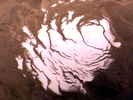









  


|
An Expedition to the South Pole

 Weather, climate, and the water cycle on Earth are studied by comparing the results of thousands of individual studies conducted using a vast variety of instruments in many different locations. Exploration of other planets requires a much
more selective process. With each rare opportunity to study Mars, this
being only the fourth in human history, scientific investigators must carefully
decide what instruments to send and where to send them. For the study of
volatiles and climate, the polar regions of Mars are ideal sites . The
poles are where the seasonal extremes occur, where the volatiles interact
with the surface, where the climate changes are recorded, and where buried
volatiles are most likely to be found. The polar environment is more severe
than the landing sites of previous missions and less is known about the
site to ensure the safety of the spacecraft, but the exploration of this
new territory will be an exciting and significant step in Mars research. Weather, climate, and the water cycle on Earth are studied by comparing the results of thousands of individual studies conducted using a vast variety of instruments in many different locations. Exploration of other planets requires a much
more selective process. With each rare opportunity to study Mars, this
being only the fourth in human history, scientific investigators must carefully
decide what instruments to send and where to send them. For the study of
volatiles and climate, the polar regions of Mars are ideal sites . The
poles are where the seasonal extremes occur, where the volatiles interact
with the surface, where the climate changes are recorded, and where buried
volatiles are most likely to be found. The polar environment is more severe
than the landing sites of previous missions and less is known about the
site to ensure the safety of the spacecraft, but the exploration of this
new territory will be an exciting and significant step in Mars research.
Click Here to learn more about the landing site!
|



















